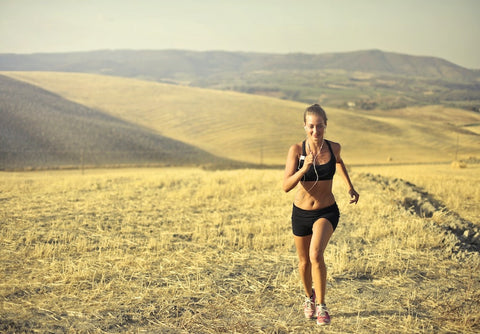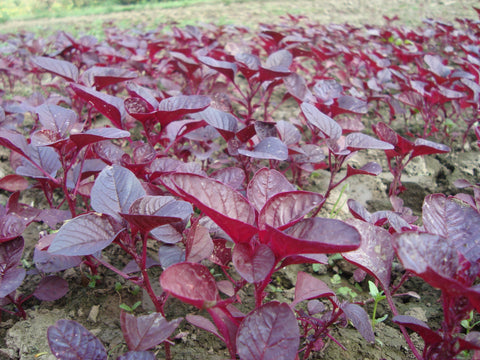20 Best Vasodilator Foods for Circulation
When does vasodilation happen?
Vasodilation happens when the smooth muscular wall of our blood vessels formed by endothelial cells relax and widen. This occurrence allows for maximum nutrients and oxygen to flow to all areas of the body - and in fact, all organs are affected by vasodilation. It’s a mechanism that we want to nurture for that reason. When vasodilation decreases, this is called vasoconstriction; meaning the flow of oxygen and nutrients carried by our blood vessels is constricted. So improvement of vasodilation can occur by removing stimuli that cause blood vessels to contract or by adding stimuli that supports blood vessel relaxation.
A healthy individual with a plant-based diet full of vasodilator foods and daily exercise can expect to have consistent vasodilation. Certain conditions impact vasodilation, some in our control, such as lifestyle choices and other unavoidable factors, like age.
Why is vasodilation necessary?
Vasodilation is a natural occurrence in our bodies. In response to a need for increased nutrients and oxygen, say during an intense workout, our tissue will release nitric oxide which dilates blood vessels. Or, when we go up high in elevation where there’s less oxygen, we need vasodilation to kick in and compensate for the reduction in oxygen. Our bodies need to have this response so that there’s a healthy, level-appropriate supply of oxygen and nutrients sent to our vital organs and muscles to help us perform at our best. To be vasodilation-vigilant means to remove factors that decrease it and increase factors that improve it.
What are the factors that decrease vasodilation?
Stress - stress contributes to vasoconstriction because it activates the sympathetic nervous system, our flight or fight response.
Age - Aging decreases the functioning of vasodilation; for example, the vasodilating gas nitric oxide is produced 10% less every decade. As we age, we have to work against this natural deterioration.
Weight - Being overweight affects the function of vasodilation and it is thought that the hyperactivity mode of the sympathetic neural system for overweight people is a big part of this reaction.
What are the factors that improve vasodilation?
Exercise - exercise-induced vasodilation happens when a boost in demand for oxygen happens by the exertion of muscles.
Temperature - heat increases vasodilation as blood vessels push heat out through the skin to keep core temperatures cool.
Elevation - The decrease in oxygen that occurs as we go up in elevation causes the body to respond by increasing vasodilation to help maintain oxygen levels throughout the body.
Diet - One of the greatest factors that impact vasodilation is the foods we eat. Higher fat, salt, and sugar content in foods produce vasoconstricting effects, while a plant-based diet high in vasodilator foods help keep arteries and blood vessels relaxed and transport vital nutrients and oxygen.
Top 20 Vasodilator Foods
Beets

Considered a major vasodilator food for its intense oxygen delivery, beets increase nitrate intake, which the body converts to nitric oxide. This potent vasodilating gas is a marker of health and vitality. Beets have been a core subject of study and usage in promoting overall health and sports supplementation.
Red Spinach

Red spinach is the new beet. The amaranth plant (not technically spinach) has been discordant to have an even higher nitrate concentration per weight than beets. It’s a durable plant that is challenging to find in the market but can be sourced clean from red spinach plant to powder with no additives. Because of its high nitrate content, top athletes leverage red spinach for the ultimate nitric oxide boost.
Green Spinach
Ubiquitous in any market, is associated with cardiovascular health because of its powerful vasodilating property, a rise in nitric oxide levels.
Pomegranate

According to research, the polyphenols in pomegranates are more powerful in their vasodilating properties than other fruits containing polyphenols.
Tart Cherry
In clinical studies, many varieties of tart cherry juice have proven time and time again as a powerful weapon for health and reduced cardiovascular events.
Swiss Chard
A part of the Chenopodiaceae subfamily of the higher Amaranthaceae family of plants is related to beets and spinach. As a chenopodium plant, it induces relaxation of smooth muscle around blood vessel walls.
Oranges

Hesperidin is a flavinoid in orange juice that has been associated with a remarkable impact on vasodilation, according to research. Citrus fruits contain Vitamin C, a powerful antioxidant; as a group, they are also responsible for protecting and increasing the lifespan of nitric oxide in the body.
Garlic
The gasses that garlic helps the body produce and regulate are its biggest contributors to vasodilation. The polysulfides in garlic stimulate the production of vascular hydrogen sulfide as well as regulate the production of endothelial nitric oxide, both of which are types of signaling molecules that help the body communicate and transport vital oxygen and nutrients.
Arugula, Kale, and other Leafy Greens
Leafy greens contain high amounts of nitrate, which help facilitate more nitric oxide production via the nitrate‐nitrite‐NO pathway. Leafy green’s potassium contents also help counteract heavy salt intake helping to make leafy greens a vital dietary contributor to vasodilation.
Beans
Legumes are recommended to eat for longevity and heart health. Many components contribute to this dietary staple, including a high rate of dietary nitrate. Studies show that intake of legumes four times a week can significantly improve cardiovascular health.
Walnuts
A regarded source of L-arginine, a nitric oxide precursor, walnuts contain some of the highest antioxidants of any nuts, making it a top nut for vasodilation.
Watermelon

one of the greatest known sources of L-citrulline which makes L-arginine bioavailable for nitric oxide synthase and boosts vasodilation.
Berries
Including blueberries, strawberries, raspberries, and blackberries, c contain powerful flavonoids which include anthocyanin and proanthocyanidin that substances reduce cell damage and have been shown to increase the production of nitric oxide in blood vessels.
Tea
Both green tea and black tea help vasodilation by way of EGCG and theaflavins, respectively. Studies conclude that tea is a powerful contributor to cardiovascular and metabolic health.
Almonds
Contributing to healthy cholesterol levels, almost produce a boost of L-Arginine to the system that prompts nitric oxide production which improves vasodilation.
Chickpeas
containing some of the highest rates of L-arginine, chickpeas not only help vasodilation by direct supply of the important amino acid but also help in weight management.
Spirulina
Studies on the SP6 peptide in spirulina show dramatic support in endothelial vasorelaxation and are an extremely useful food for heart health.
Watercress
Packs in powerful amounts of nitrate and antioxidants, especially carotenoids that aid in reducing the oxygen necessary for executing exhaustive tasks and also support a healthy heart by way of increasing vasodilation.
Mango
Studies show that within 2 hours of consuming mangoes, relaxation of blood vessels occurs. Mangoes contain many antioxidants, especially beta-carotene, such as carotenoids help regulate endothelial function.
Sweet potatoes
a well-known heart-healthy food. Orange flesh sweet potatoes contain higher concentrations of protein, flavonoids, anthocyanins, and carotenoids than white flesh sweet potatoes and promote vasodilation.
How nitric oxide works to increase vasodilation
Nitric oxide is a gaseous molecule that is produced by the body in various ways. It is a signaling molecule produced by almost every cell type in the body. Nitric oxide plays a core role in vasodilation by relaxing the smooth muscle around blood vessels allowing a widening effect to occur. Nitric oxide is a determining health factor according to leading doctors.
The NutriGarden family of products were made to boost nitric oxide levels for everyday health and punctuated athletic performance. Our labels are the cleanest on the market, providing 100% plant-based, vasodilator food ingredients for nitric oxide boosting that are vegan, Non-GMO, preservative-free, gluten-free, with no added sugar or artificial flavor.
Resources
Ramanlal R, Gupta V. Physiology, Vasodilation. [Updated 2021 Mar 29]. In: StatPearls [Internet]. Treasure Island (FL): StatPearls Publishing; 2021 Jan-. Available from: https://www.ncbi.nlm.nih.gov/books/NBK557562/
Peter Bärtsch And J. Simon R. Gibbs. Effect of Altitude on the Heart and the Lungs. Circulation. Originally published 6, Nov 2007;116:2191–2202. https://doi.org/10.1161/CIRCULATIONAHA.106.650796
Sarelius, I., & Pohl, U. (2010). Control of muscle blood flow during exercise: local factors and integrative mechanisms. Acta physiologica (Oxford, England), 199(4), 349–365. https://doi.org/10.1111/j.1748-1716.2010.02129.x
Charkoudian N. (2003). Skin blood flow in adult human thermoregulation: how it works, when it does not, and why. Mayo Clinic proceedings, 78(5), 603–612. https://doi.org/10.4065/78.5.603
Bekuzarova, S. A., Khromov, A. S., Doloman, L. B., Beslaneev, I. A., & Kurdanov, K. (2003). Usilenie vazodilatatsii na nitroglitserin v usloviiakh vysokogor'ia [Effect of nitroglycerin on vasodilation at high altitude]. Fiziolohichnyi zhurnal (Kiev, Ukraine : 1994), 49(3), 118–125.
Wolff C. B. (2000). Cerebral blood flow and oxygen delivery at high altitude. High altitude medicine & biology, 1(1), 33–38. https://doi.org/10.1089/152702900320667
Harris, C. W., Edwards, J. L., Baruch, A., Riley, W. A., Pusser, B. E., Rejeski, W. J., & Herrington, D. M. (2000). Effects of mental stress on brachial artery flow-mediated vasodilation in healthy normal individuals. American heart journal, 139(3), 405–411. https://doi.org/10.1016/s0002-8703(00)90083-8
Marie Gerhard, Mary-Anne Roddy, Shelly J. Creager, and Mark A. Creager. Aging Progressively Impairs Endothelium-Dependent Vasodilation in Forearm Resistance Vessels of Humans. Originally published1 Apr 1996 Hypertension. 1996;27:849–853. https://doi.org/10.1161/01.HYP.27.4.849
Stapleton, P. A., James, M. E., Goodwill, A. G., & Frisbee, J. C. (2008). Obesity and vascular dysfunction. Pathophysiology : the official journal of the International Society for Pathophysiology, 15(2), 79–89. https://doi.org/10.1016/j.pathophys.2008.04.007
Barnard, N. D., Goldman, D. M., Loomis, J. F., Kahleova, H., Levin, S. M., Neabore, S., & Batts, T. C. (2019). Plant-Based Diets for Cardiovascular Safety and Performance in Endurance Sports. Nutrients, 11(1), 130. https://doi.org/10.3390/nu11010130
Domínguez, R., Cuenca, E., Maté-Muñoz, J. L., García-Fernández, P., Serra-Paya, N., Estevan, M. C., Herreros, P. V., & Garnacho-Castaño, M. V. (2017). Effects of Beetroot Juice Supplementation on Cardiorespiratory Endurance in Athletes. A Systematic Review. Nutrients, 9(1), 43. https://doi.org/10.3390/nu9010043
Jovanovski, E., Bosco, L., Khan, K., Au-Yeung, F., Ho, H., Zurbau, A., Jenkins, A. L., & Vuksan, V. (2015). Effect of Spinach, a High Dietary Nitrate Source, on Arterial Stiffness and Related Hemodynamic Measures: A Randomized, Controlled Trial in Healthy Adults. Clinical nutrition research, 4(3), 160–167. https://doi.org/10.7762/cnr.2015.4.3.160
Roelofs, E. J., Smith-Ryan, A. E., Trexler, E. T., Hirsch, K. R., & Mock, M. G. (2017). Effects of pomegranate extract on blood flow and vessel diameter after high-intensity exercise in young, healthy adults. European journal of sport science, 17(3), 317–325. https://doi.org/10.1080/17461391.2016.1230892
Karen M Keane, Trevor W George, Costas L Constantinou, Meghan A Brown, Tom Clifford, Glyn Howatson, Effects of Montmorency tart cherry (Prunus Cerasus L.) consumption on vascular function in men with early hypertension, The American Journal of Clinical Nutrition, Volume 103, Issue 6, June 2016, Pages 1531–1539, https://doi.org/10.3945/ajcn.115.123869
Assaidi, A., Dib, I., Tits, M., Angenot, L., Bellahcen, S., Bouanani, N., Legssyer, A., Aziz, M., Mekhfi, H., Bnouham, M., Frederich, M., & Ziyyat, A. (2019). Chenopodium ambrosioides induces an endothelium-dependent relaxation of rat isolated aorta. Journal of integrative medicine, 17(2), 115–124. https://doi.org/10.1016/j.joim.2019.01.006
Morand, C., Dubray, C., Milenkovic, D., Lioger, D., Martin, J. F., Scalbert, A., & Mazur, A. (2011). Hesperidin contributes to the vascular protective effects of orange juice: a randomized crossover study in healthy volunteers. The American journal of clinical nutrition, 93(1), 73–80. https://doi.org/10.3945/ajcn.110.004945
Ried, K., & Fakler, P. (2014). Potential of garlic (Allium sativum) in lowering high blood pressure: mechanisms of action and clinical relevance. Integrated blood pressure control, 7, 71–82. https://doi.org/10.2147/IBPC.S51434
Shubha & Mukherjee, Anirban & Tamta, Manisha & Koley, Tanmay. (2019). Arugula (Eruca vesicaria subsp. sativa (Miller) Thell.): A healthy leafy vegetable. 10.13140/RG.2.2.22117.35041. https://www.researchgate.net/publication/337592972_Arugula_Eruca_vesicaria_subsp_sativa_Miller_Thell_A_healthy_leafy_vegetable/citation/download
Lidder, S., & Webb, A. J. (2013). Vascular effects of dietary nitrate (as found in green leafy vegetables and beetroot) via the nitrate-nitrite-nitric oxide pathway. British journal of clinical pharmacology, 75(3), 677–696. https://doi.org/10.1111/j.1365-2125.2012.04420.x
Nouri, F., Sarrafzadegan, N., Mohammadifard, N. et al. Intake of legumes and the risk of cardiovascular disease: frailty modeling of a prospective cohort study in the Iranian middle-aged and older population. Eur J Clin Nutr 70, 217–221 (2016). https://doi.org/10.1038/ejcn.2015.153





Comments (0)
There are no comments for this article. Be the first one to leave a message!